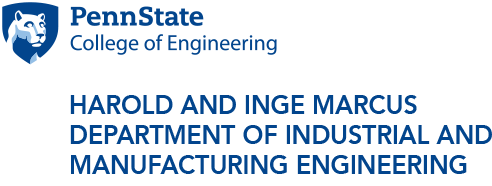M.S. in Industrial Engineering (non-thesis track)
NOTE: Students do not need to select an option to earn the master of science degree in this track.
A minimum of 32 credits consisting of 27 credits of coursework, 2 credits of IE Colloquium, and 3 credits of paper/research are required to complete the M.S. in Industrial Engineering in the non-thesis track. Note that IE 596: Individual Studies credits cannot be applied towards the 24 credits of coursework. There are no special language requirements. All requirements of the J. Jeffrey and Ann Marie Fox Graduate School, as set forth in the Penn State Graduate Degree Programs Bulletin, must be satisfied.
Course Requirements
NOTE: Course descriptions can be found in the Graduate Bulletin.
- 2 or more credits of IE 590: IE Colloquium – pass/fail grading; one IE 590 credit can be substituted by one credit of OR 590: Operations Research Colloquium
- 3 or more credits of IE 596: Paper Research — graded “R”
- 27 or more credits of coursework: 18 or more credits of IE course credits (excluding IE 596), 15 or more credits of IE course credits at the 500-level, 9 or fewer credits of non-IE course credits, a total of 18 or more IE and non-IE 500-level course credits
- IE 505: Linear Programming
- IE 511: Experimental Design in Engineering
PLEASE NOTE: There are prerequisites to these courses that are identified in the Graduate Bulletin. If you have any additional concerns about whether you have the appropriate background to succeed in these courses, please contact the Graduate Program Office.
Students must receive prior approval from the department’s graduate program coordinator before taking any 400-level courses. Not all 400-level elective courses can be taken for graduate credit. Also, please note that IE 400-level required courses (required for the undergraduate degree in industrial engineering) cannot be taken for industrial engineering graduate credit.
Paper Requirements
The paper must demonstrate the capability of the student to integrate and apply concepts and techniques learned in the courses to solve an engineering problem. The scope of the culminating project resulting in this paper must be specified by the student's research adviser who is selected by the student during the first semester of coursework.
The electronic copy of the approved culminating research paper must be submitted to the graduate program coordinator at least two weeks before the end of the terminal semester (which will be the summer following enrollment for a typical student). This scholarly paper will be made publically available through posting on ScholarSphere.
The format of the final paper shall be based on the thesis formatting guidelines specified by the Fox Graduate School. At least one reader other than the student’s adviser must sign the approval page for the paper, in addition to the department head. The adviser must be a member of the graduate faculty from the department and the reader could be a graduate faculty member from either within the department or outside the department. Please note that a minimum of two days is required to obtain the department head’s signature.
Typical Time Sequence
Most students will complete the degree requirements — including all required coursework and the 3 credits of culminating research resulting in a paper — and graduate by the end of summer following the second semester. Although the track is designed as a three-semester program, it is recognized that additional time may be needed to complete the scholarly paper. Therefore, students need not graduate within one year and would be permitted to complete the scholarly paper off campus. For the typical student in the non-thesis track, the proposed plan of study is as follows:
- Fall semester: 12 credits of coursework, 1 credit of IE 590, and 1 credit of IE 596
- Spring semester: 12 credits of coursework, 1 credit of IE 590 or 1 credit of OR 590, and 1 credit of IE 596
- Summer semester: 3 credits of coursework and 1 credit of IE 596
Total credits: 27 credits of coursework, 2 credits of IE 590 (or 1 credit of IE 590 and 1 credit of OR 590), and 3 credits of IE 596.
Resident Graduate Programs:
- Overview
- Master of Science
- Doctor of Philosophy
- Dual Degrees
- Collaborative Degrees
Contact Information:
- Graduate Program Office
344 Leonhard Building
University Park, PA 16802
814-863-1269
imegradoffice@psu.edu





